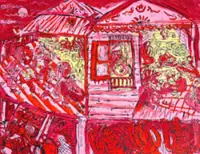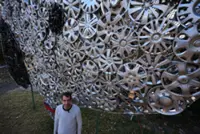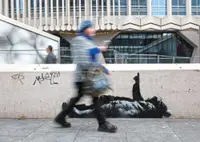Azman is relishing the return to basics, capturing the soul of the city through his urban sketches. Here, he poses with his drawing of the iconic Sultan Abdul Samad Building in Kuala Lumpur - a tribute to heritage through pen and paper. Photo: The Star/Azman Ghani
After three decades in architecture and public service, Datuk Azman Mohd Hashim is finding new meaning in old places.
As president of the Board of Architects Malaysia and a senior director at the Public Works Department (JKR), his days are packed with responsibility – but it’s in the quiet moments, felt-tip pen in hand, that he reconnects with the heart of his profession.
“After 30 years of doing the same thing,” he reflects, “I felt that I wanted to try something new and find my own style.”
This journey led him back to something he’s loved since school – sketching. What started as a quiet hobby has evolved into something deeply personal and unexpectedly influential.
Now, Azman, 58, is not only drawing iconic buildings from his travels, but also sharing them with the world through his sketchbook, social media and even in university lectures.
He carries an A5 sketchbook with him everywhere he goes. Each sketch lives on a right-hand page, perfectly centred with a clean border (he likes to keep things “pure” he says), while notes fill the page on the left: “My feelings, to remind me of the place or the time. Just like a small diary,” he says.
You’ll find sketches, scribbles and notes from all over Malaysia and the globe including interesting heritage buildings in Morocco, Russia, Greece, Italy, Indonesia, Spain and the Netherlands.
When he started his Instagram account last year, the reaction surprised him.
“People responded with likes. Some universities, including UiTM, invited me as a guest lecturer to share with students.”
Have sketchbook, will travel
Azman, who is based in Sentul, Kuala Lumpur, talks about his sketching experiences.
“Usually on overseas trips I am on location. In Malaysia, I find it a little more challenging. There are so many distractions and the weather is not very agreeable either.
“So I look for photos, ones that really attract my attention with the colours and composition, and I sketch them while I am at home.”
Currently involved in heritage projects for Malaysian embassies in Paris (France), Brussels (Belgium) and Rome (Italy), Azman describes heritage buildings with deep affection.
“To me, a building is like an old person,” he says. “And like how one would care for an old person, I feel the same way for these old buildings.”
A local favourite building is the Sultan Abdul Samad building in KL and he readily admits that he is drawn to domes.
“Because of the proportions, balance and symmetry ... sketching the shadows on a dome is something I enjoy tremendously.”
A recent visit to Bangunan Sulaiman and the National Mosque in KL left a powerful impression.
Azman was raving about the five-storey Bangunan Sulaiman designed in Art Deco style and completed in 1930 as well as the National Mosque, which was completed in 1965. The mosque has a 73m-high minaret and a 16-pointed star concrete main roof.
“I am very passionate about these buildings. The intricacy of the designs is fascinating. I often wonder how back in those days they were able to think in this sort of manner. I touched the marble while I was in the mosque and it immediately transported me to my schoolboy days,” he shares.
Azman recalls his first school trip to KL as a boy, visiting the National Mosque and Tugu Negara.
“Now at my age, it is a cherished reminiscence ... I can still remember how I felt as a boy. So it’s extra special that now it’s also my job to conserve these buildings.”
While he has always loved sketching and realised he was quite good at it when he sat for his lukisan (drawing) exams for the Sijil Rendah Pelajaran, the Kedah-born father of two pursued architecture after attending technical school.
“I studied at the KPP/ITM Kolej Pengajian Persediaan-Institut Teknologi Mara, before heading off to the University of Houston (in Texas, United States) for my Bachelor of Architecture.
“When I came back, I started working for a private architectural firm in Kedah but I was dissatisfied with working in a small town, so I decided to come to KL and work for JKR in 1992. I’ve been here ever since.”
Sketching has become part of his mission these days. He recently created a Hari Raya card for the Board of Architects featuring the Sultan Suleiman Royal Mosque in Klang, one of his many contributions that blend art with advocacy.
On occasion, Azman joins groups like the KL Urban Sketchers, which recently spent a morning observing and sketching the buildings around Merdeka 118. He joined them in sketching the YWCA Kuala Lumpur.
“While I prefer to sketch on my own, it was also fun observing how others work.”
Turning point
It was after a health scare in 2022 that Azman found clarity in his artistic voice.
“I feared that it would be the end of my sketching days,” he says.
He was admitted at the Putrajaya Hospital for an extended period, but as he recovered, something changed.
“I was determined to find my own style. It was only in 2022 that I settled into my own very sketchy, loose technique. When people look at my sketches these days, they know right away that this is me,” says Azman.
That distinctive approach includes bold use of colour and a preference for Ecoline, a vibrant and unforgiving liquid ink.
“It’s unlike normal watercolours. Every application is done only once; there’s no layering. There’s no making mistakes, it’s a little tricky. To me, painting with Ecoline is in a different league, plus it’s very hard to find in Malaysia.”
In an interview with the Malaysian Institute of Interior Design, Azman said that older generation architects would be more familiar with Ecoline, as they used it to colour submission plans in the early days.
“The younger generation would not be as familiar with this technique as all the submissions are done using computers these days.”
While he loves the vibrancy and boldness of Ecoline colours, some of Azman’s sketches remain just black and white.
For him, sketching is a sanctuary.
“It is time for your self. I get so stressed with work sometimes. But sketching is my ‘me time’.
“During the weekends, after a quick and simple breakfast with my wife, I put on some music and spend time drawing and painting alone. It can be very therapeutic.”
Is there a larger goal in mind when it comes to the sketches?
“I don’t have any monetary goals, if that’s the question. It’s just something that I want to do. The desire to share and document these great and unique buildings of the world in the hope that someday people will look at these drawings and learn something.
“Every building has a story to tell. And these are my way of telling them,” he concludes.










